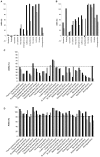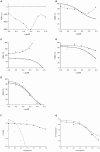Tuning a 96-well microtiter plate fluorescence-based assay to identify AGE inhibitors in crude plant extracts
- PMID: 24256925
- PMCID: PMC6270619
- DOI: 10.3390/molecules181114320
Tuning a 96-well microtiter plate fluorescence-based assay to identify AGE inhibitors in crude plant extracts
Abstract
Advanced glycation end-products (AGEs) are involved in the pathogenesis of numerous diseases. Among them, cellular accumulation of AGEs contributes to vascular complications in diabetes. Besides using drugs to lower blood sugar, a balanced diet and the intake of herbal products potentially limiting AGE formation could be considered beneficial for patients' health. The current paper presents a simple and cheap high-throughput screening (HTS) assay based on AGE fluorescence and suitable for plant extract screening. We have already implemented an HTS assay based on vesperlysines-like fluorescing AGEs quickly (24 h) formed from BSA and ribose under physiological conditions. However, interference was noted when fluorescent compounds and/or complex mixtures were tested. To overcome these problems and apply this HTS assay to plant extracts, we developed a technique for systematic quantification of both vesperlysines (λ(exc) 370 nm; λ(em) 440 nm) and pentosidine-like (λ(exc) 335 nm; λ(em) 385 nm) AGEs. In a batch of medicinal and food plant extracts, hits were selected as soon as fluorescence decreased under a fixed threshold for at least one wavelength. Hits revealed during this study appeared to contain well-known and powerful anti-AGE substances, thus demonstrating the suitability of this assay for screening crude extracts (0.1 mg/mL). Finally, quercetin was found to be a more powerful reference compound than aminoguanidine in such assay.
Figures







Similar articles
-
Creatine plays a direct role as a protein modifier in the formation of a novel advanced glycation end product.J Biochem. 2002 Oct;132(4):543-50. doi: 10.1093/oxfordjournals.jbchem.a003255. J Biochem. 2002. PMID: 12359068
-
Non-invasive skin autofluorescence, blood and urine assays of the advanced glycation end product (AGE) pentosidine as an indirect indicator of AGE content in human bone.BMC Musculoskelet Disord. 2019 Dec 27;20(1):627. doi: 10.1186/s12891-019-3011-4. BMC Musculoskelet Disord. 2019. PMID: 31881872 Free PMC article.
-
Astragalosides isolated from the root of astragalus radix inhibit the formation of advanced glycation end products.J Agric Food Chem. 2009 Sep 9;57(17):7666-72. doi: 10.1021/jf9007168. J Agric Food Chem. 2009. PMID: 19681610
-
Advanced glycation endproducts in food and their effects on health.Food Chem Toxicol. 2013 Oct;60:10-37. doi: 10.1016/j.fct.2013.06.052. Epub 2013 Jul 16. Food Chem Toxicol. 2013. PMID: 23867544 Review.
-
Review of pentosidine and pyrraline in food and chemical models: formation, potential risks and determination.J Sci Food Agric. 2018 Jul;98(9):3225-3233. doi: 10.1002/jsfa.8853. Epub 2018 Feb 22. J Sci Food Agric. 2018. PMID: 29280151 Review.
Cited by
-
Identification of Covalent Cyclic Peptide Inhibitors Targeting Protein-Protein Interactions Using Phage Display.J Am Chem Soc. 2025 Mar 5;147(9):7461-7475. doi: 10.1021/jacs.4c15843. Epub 2025 Feb 24. J Am Chem Soc. 2025. PMID: 39993812
-
Unlocking the Therapeutic Potential of Stevia rebaudiana Bertoni: A Natural Antiglycating Agent and Non-Toxic Support for HDF Cell Health.Molecules. 2023 Sep 25;28(19):6797. doi: 10.3390/molecules28196797. Molecules. 2023. PMID: 37836640 Free PMC article.
-
Screening and Characterization of Antiglycoxidant Anthocyanins from Vaccinium myrtillus Fruit Using DPPH and Methylglyoxal Pre-Column HPLC Assays.Antioxidants (Basel). 2020 Jun 10;9(6):512. doi: 10.3390/antiox9060512. Antioxidants (Basel). 2020. PMID: 32532151 Free PMC article.
-
Absolute Configuration of Mycosporine-Like Amino Acids, Their Wound Healing Properties and In Vitro Anti-Aging Effects.Mar Drugs. 2019 Dec 31;18(1):35. doi: 10.3390/md18010035. Mar Drugs. 2019. PMID: 31906052 Free PMC article.
-
The Influence of Cationic Nitrosyl Iron Complex with Penicillamine Ligands on Model Membranes, Membrane-Bound Enzymes and Lipid Peroxidation.Membranes (Basel). 2022 Nov 2;12(11):1088. doi: 10.3390/membranes12111088. Membranes (Basel). 2022. PMID: 36363643 Free PMC article.
References
-
- Maillard L.C. Action des acides aminés sur les sucres; formation des mélanoïdes par voie méthodique. C. R. Acad. Sci. 1912;154:66–67.
-
- WHO Diabetes. [(accessed 20 June 2012)]. Available online: http://www.who.int/topics/diabetes_mellitus/en/
Publication types
MeSH terms
Substances
LinkOut - more resources
Full Text Sources
Other Literature Sources

